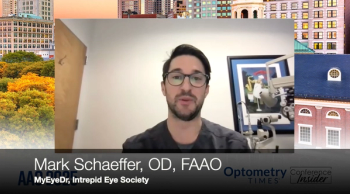
- January digital edition 2024
- Volume 16
- Issue 01
Advancing multifocal contact lens design with biometry
Osama Said, OD, details the advancements made to multifocal contact lenses, and what biometric considerations clinicians undertake for their patients.
Since multifocal contact lenses first came to market in the 1980s,4 they have faced a number of challenges and drawbacks that limited their adoption and satisfaction among wearers and providers. In the early decades, the design of multifocal contact lenses did not address individual variations in the lens wearer’s ocular biometry, metrics such as pupil size and axial length. The lack of biometric customization contributed to suboptimal visual performance, increased visual disturbance, and to lens wearer dropout.
Compared to the multifocal contact lenses of the past, today’s premium lenses are intricately designed to ensure that lens wearers enjoy both comfort and an optimized visual experience. This is because, among other advancements, today's designs combine superior lens materials and sophisticated optical designs, and some even incorporate patient biometrics data.5
While biometric considerations have long been standard in the management of various ocular conditions, they have only recently gained attention as a key aspect of contact lens design. As with procedures such as cataract and refractive surgeries, we now have a greater appreciation of the profound impact that biometrics can have on the overall visual performance of multifocal contact lenses.
Notably, Acuvue Oasys Max 1‑Day Multifocal contact lens (Johnson & Johnson Vision), a recent entry to the multifocal contact lens category Acuvue Oasys Max 1‑Day Multifocal contact lens (Johnson & Johnson Vision), includes 1 patient biometric in its design: pupil size.6 The recently launched Infuse One-Day Multifocal contact lens (Bausch + Lomb) incorporates in its design 7 relevant biometric factors—including pupil size variations—that were measured across a large population of presbyopes.7
Accommodating ocular biometrics: Pupil size
Among the ocular biometric factors that affect lens wearer experience, pupil size is the most important factor one to consider during lens design and fitting. The pupil controls the amount of light that enters the eye, and its size is influenced by a variety of endogenous and environmental conditions.8 Crucially, pupil size fluctuates due to pupillary adaptation, a process controlled by the iris muscles in response to fluctuations in ambient lighting. Individuals experiencing presbyopia and/or advanced age tend to have smaller pupils, which contributes to a diminished capacity to adapt to variations in lighting conditions.9
Most contemporary multifocal designs operate on the principle of simultaneous image formation, in which different powered areas within the optic zone form multiple images at various distances. Under certain circumstances, this design can contribute to undesirable visual side effects, including halos and glares. These effects may be particularly noticeable when the pupil is significantly larger than the optic zone, such as in low illumination conditions.10 Thus, a multifocal contact lens designed with presbyopes’ pupil size in mind can significantly reduce potential visual defects and enhance the overall visual experience.
In practice, lens designers can adjust the size of the optical zone to match the amount of ADD power because more ADD is generally needed for older patients with smaller pupils. This improves upon earlier multifocal contact lenses that primarily differed only by their ADD power.
Pupil size is equally significant in the process of selecting a contact lens that is compatible with each patient’s unique biometrics. The fitting process is another important consideration, as fitting with a line of multifocals that is were designed with consideration to eye biometrics can significantly streamline the lens-fitting process. This helps to reduce chair time and improve customer satisfaction.
Other important ocular biometrics
In addition to pupil size, advanced multifocal contact lens designs incorporate other relevant biometrics, including anterior chamber depth, higher-order aberrations, axial length, corneal curvature, residual accommodation, and subjective refraction.6
Much like pupil size, axial length is affected by age-related variations, increasing during childhood, and decreasing in adulthood.11,12 Corneal curvature is also affected by age-related changes,13 but the variations are generally mild relative to other biometrics. Nonetheless, it is important to assess corneal curvature during the an exam to confirm that a patient's curvature falls within the normal range. Any detected irregularities in corneal curvature, integrity, or health should be promptly addressed before contact lens wear.
Lenticular changes can influence the contact lens wear experience as the eye’s natural lenses lose elasticity, thicken, and develop opacity with age. Collectively, these and other factors play an important role in shaping the overall wear experience, so lenses crafted with biometrics in mind can provide an optimized level of visual performance.
Optimizing lenses for presbyopes
In recent decades, multifocal contact lens technology has advanced, with the goal of unparalleled comfort and performance. Today’s premium multifocal lenses are predominantly made of soft silicone hydrogel materials that enhance comfort, breathability, and overall eye health. Daily disposable options can provide further comfort and convenience. that many wearers desire.14
For those providers and patients with a negative view of multifocal contact lenses that likely originated from poor experiences with past designs, I recommend that providers and patients alike reconsidering multifocal contact lenses as an excellent option for the correction of presbyopia. The latest lineup of lenses are worth considering, as eye care providers may be pleasantly surprised by the ease of fit and significantly enhanced performance of today’s multifocals—a stark contrast to the lenses introduced even a few years ago.
For presbyopes who experienced less than optimal performance with multifocals, I would focus on 2 potential leading causes. First, due to the mobile nature of contact lenses, they can sometimes become decentered on the eye, resulting in misalignment of the optic zones. Lenses become decentered mainly due to dry eye. Poor lubrication can lead to cause a contact lens adhering to adhere to the ocular surface, shifting it off center. The use of lubricating drops specifically designed for contact lens use can help rehydrate the lens and corneal surface.
The second concern is a universal challenge with all contact lenses: any disruptions in tear production or disturbances in ocular surface homeostasis can reduce comfort and potentially lead to discontinuation of use. Although maintaining ocular surface homeostasis is a concern for all contact lens wearers, it becomes a greater concern for our presbyopic patients with presbyopia. It is well documented that as we age, it is well-documented that tear volume decreases and patients have increased meibomian gland dysfunction. I address these issues by treating the root cause of a patient's dry eye concomitantly with recommending contact lenses that are specifically designed to maintain ocular surface homeostasis. As first-line therapy, I usually educate the patient on maintaining good eyelid hygiene, using warm compresses twice per day, and applying more viscous gel tears at bedtime. If the disruption is minimal, it dry eye can be treated concomitantly with contact lens use. For these reasons and more, it is critical to select the right multifocal contact lens, particularly using one that incorporates several patient biometric factors into the its design.
To educate my patients who are undecided about trying multifocal contact lenses, I have found it helpful to describe the expected visual performance relative to progressive glasses. Compared to progressive glasses, which provide 100% performance at both distance distant and near regions, the early iterations of multifocals only reached up to 80% performance at both distances. However, the performance of multifocals has seen significant enhancement, reaching around 95% of what progressive glasses can offer, and new advancements will propel these lenses closer to 100% in upcoming years. Instead of waiting for perfection, I inform my patients that the current lines of multifocals have close to optimal performance at all distances, without compromising on either near or far vision.
Future of multifocals
Compared to the first commercially available multifocal contact lenses, today’s options have improved significantly in terms of comfort and performance. Today's lenses are made of materials and ingredients that better support comfort and ocular health, while and their advanced lens designs reduce visual defects and improve visual outcomes.
Multifocal contact lenses that incorporate biometrics into their design further enhance customization and streamline fitting. As multifocal innovations continue to develop, eye care providers and their patients should look at multifocals in a new light, as a reliable alternative to progressive glasses.
References
Berdahl J, Bala C, Dhariwal M, Lemp-Hull J, Thakker D, Jawla S. Patient and economic burden of presbyopia: a systematic literature review. Clin Ophthalmol. 2020;14:3439-3450. doi:10.2147/OPTH.S269597. PMID: 33116396; PMCID: PMC7588278
Berdahl J, Bala C, Dhariwal M, Lemp-Hull J, Thakker D, Jawla S. Patient and economic burden of presbyopia: a systematic literature review. Clin Ophthalmol Auckl NZ. 2020;14:3439-3450.
Patel K, Petry E, Lighthizer N. Presbyopia by the numbers: who is affected by it? Presbyopia Physician. 2022;2(June 2022): 24-26. Accessed November 13, 2023.
https://www.presbyopiaphysician.com/issues/2022/june-2022/presbyopia-by-the-numbers-who-is-affected-by-it .Alvarez-Peregrina C, Sanchez-Tena MA, Martin M, Villa-Collar C, Povedano-Montero FJ. Multifocal contact lenses: a bibliometric study. J Optom. 2022;15(1):53-59. doi:10.1016/j.optom.2020.07.007.
Grant NJ, Fujimoto MJ, Caroline PJ, Norman CW. History of contact lenses. Contact Lens Spectr. 2021;:36(CLS Special Edition 2021):52-54. Accessed November 13, 2023.
https://www.clspectrum.com/supplements/2021/november-2021/contact-lens-spectrum-special-edition-2021-celebra/history-of-contact-lenses .Schaeffer D. Advances in multifocal contact lens technologies. Vision Monday. Published June 18, 2023. Accessed September 21, 2023.
http://www.visionmonday.com/eyecare/article/advances-in-multifocal-contact-lens-technologies/ Acuvue Oasys Max 1-Day Multifocal. Acuvue. Accessed November 14, 2023.
https://www.acuvue.com/contact-lenses/acuvue-oasys-max-1-day-multifocal Infuse 1-day multifocal contact lenses. Bausch + Lomb. Accessed November 14, 2023.
https://ecp.bauschcontactlenses.com/products/infuse-one-day/multifocal/ Coats J. Pupil size matters in presbyopia treatment. Optometry Times. 2021;13(9). Accessed November 14, 2023.
https://www.optometrytimes.com/view/pupil-size-matters-in-presbyopia-treatment Guillon M, Dumbleton K, Theodoratos P, Gobbe M, Wooley CB, Moody K. The effects of age, refractive status, and luminance on pupil size. Optom Vis Sci. 2016;93(9):1093-1100.doi:10.1097/OPX.0000000000000893.
Monsálvez-Romín D, González-Méijome JM, Esteve-Taboada JJ, García-Lázaro S, Cerviño A. Light distortion of soft multifocal contact lenses with different pupil size and shape. Cont Lens Anterior Eye. 2020;43(2):130-136. doi:10.1016/j.clae.2019.11.014
Rozema JJ, Ní Dhubhghaill S. Age-related axial length changes in adults: a review. Ophthalmic Physiol Opt. 2020;40(6):710-717. doi:10.1111/opo.12728.
Bach A, Villegas VM, Gold AS, Shi W, Murray TG. Axial length development in children. Int J Ophthalmol. 2019;12(5):815-819. doi:10.18240/ijo.2019.05.18.
Hashemi H, Asgari S, Emamian MH, Mehravaran S, Fotouhi A. Age-related changes in corneal curvature and shape: the Shahroud Eye Cohort study. Cornea. 2015;34(11):1456-1458. doi:10.1097/ICO.0000000000000595
McCormick E. What consumers really want. Optom Today. Published January 4, 2020. Accessed November 15, 2023.
https://www.aop.org.uk/ot/industry/contact-lenses/2020/01/04/what-consumers-really-want
Articles in this issue
almost 2 years ago
The magic of perfluorohexyloctanealmost 2 years ago
Diagnosing and treating Demodex blepharitisalmost 2 years ago
Why is contrast sensitivity important?almost 2 years ago
What’s your clinical protocol for managing diabetic retinopathy?almost 2 years ago
Looking forward to improving and lessening the allergic responsealmost 2 years ago
Cut out the cigarettes for the sake of the optic nerveNewsletter
Want more insights like this? Subscribe to Optometry Times and get clinical pearls and practice tips delivered straight to your inbox.



















































.png)


